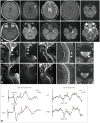Atypical Meningoencephalomyelitis Following Varicella Zoster Virus Infection
- PMID: 38433487
- PMCID: PMC10921040
- DOI: 10.3988/jcn.2023.0332
Atypical Meningoencephalomyelitis Following Varicella Zoster Virus Infection
Conflict of interest statement
The authors have no potential conflicts of interest to disclose.
Figures

Similar articles
-
Severe varicella-zoster virus meningoencephalomyelitis coexisting with visceral disseminated varicella-zoster virus infection in a patient with lupus nephritis: A case report.Medicine (Baltimore). 2023 Apr 7;102(14):e33459. doi: 10.1097/MD.0000000000033459. Medicine (Baltimore). 2023. PMID: 37026945 Free PMC article.
-
Acute meningoencephalomyelitis due to varicella-zoster virus in an AIDS patient: report of a case and review of the literature.Rev Soc Bras Med Trop. 2011 Nov-Dec;44(6):784-6. doi: 10.1590/s0037-86822011000600026. Rev Soc Bras Med Trop. 2011. PMID: 22231256 Review.
-
[Reactivation of herpes zoster infection by varicella-zoster virus].Med Pregl. 1999 Mar-May;52(3-5):125-8. Med Pregl. 1999. PMID: 10518396 Review. Croatian.
-
Varicella in patients infected with the human immunodeficiency virus.Arch Dermatol. 1990 Aug;126(8):1033-6. Arch Dermatol. 1990. PMID: 2166482
-
Varicella zoster meningitis: an atypical case of zoster reactivation in immunocompetent young adult.BMJ Case Rep. 2018 Jan 5;2018:bcr2017223257. doi: 10.1136/bcr-2017-223257. BMJ Case Rep. 2018. PMID: 29305370 Free PMC article.
References
-
- McKelvie PA, Collins S, Thyagarajan D, Trost N, Sheorey H, Byrne E. Meningoencephalomyelitis with vasculitis due to varicella zoster virus: a case report and review of the literature. Pathology. 2002;34:88–93. - PubMed
-
- Tenembaum S, Chitnis T, Ness J, Hahn JS International Pediatric MS Study Group. Acute disseminated encephalomyelitis. Neurology. 2007;68(16 Suppl 2):S23–S36. - PubMed
-
- Trebst C, Raab P, Voss EV, Rommer P, Abu-Mugheisib M, Zettl UK, et al. Longitudinal extensive transverse myelitis--it’s not all neuromyelitis optica. Nat Rev Neurol. 2011;7:688–698. - PubMed
Grants and funding
LinkOut - more resources
Full Text Sources

